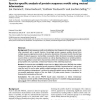38 search results - page 7 / 8 » Pfam: multiple sequence alignments and HMM-profiles of prote... |
BMCBI
2005
14 years 11 months ago
2005
Background: Protein sequence motifs are by definition short fragments of conserved amino acids, often associated with a specific function. Accordingly protein sequence profiles de...
BMCBI
2008
14 years 11 months ago
2008
Background: Amino acids responsible for structure, core function or specificity may be inferred from multiple protein sequence alignments where a limited set of residue types are ...
COMAD
2008
15 years 1 months ago
2008
An important problem in biological data analysis is to predict the family of a newly discovered sequence like a protein or DNA sequence, using the collection of available sequence...
BMCBI
2005
14 years 11 months ago
2005
Background: The 'lid' subcomplex of the 26S proteasome and the COP9 signalosome (CSN complex) share a common architecture consisting of six subunits harbouring a so-call...
98
Voted
AB
2007
Springer
15 years 5 months ago
2007
Springer
Whenever a programmer writes a loop, or a mathematician does a proof by induction, an invariant is involved. The discovery and understanding of invariants often underlies problem s...


